Digital Marketing Strategy Report for Life Trust: BU7718 Assessment
VerifiedAdded on 2022/10/10
|25
|5631
|471
Report
AI Summary
This report provides a comprehensive analysis of digital marketing strategies, focusing on customer conversion and retention for the non-profit organization, Life Trust. It begins with an introduction to marketing strategy and the significance of digital marketing in today's world, followed by an examination of customer journey mapping, highlighting touchpoints and their impact on customer experience. The report then delves into customer conversion and retention strategies, including the creation of customer personas and a case study analysis. Furthermore, it discusses the digital marketing mix, including product, place, price, promotion, people, process, and physical evidence, tailored to the organization's context. The report also explores the integration of online and offline promotion, offering recommendations and concluding with an evaluation of the effectiveness of the strategies employed by Life Trust. The assessment is based on BU7718 module and is a re-submission incorporating feedback from a previous submission.
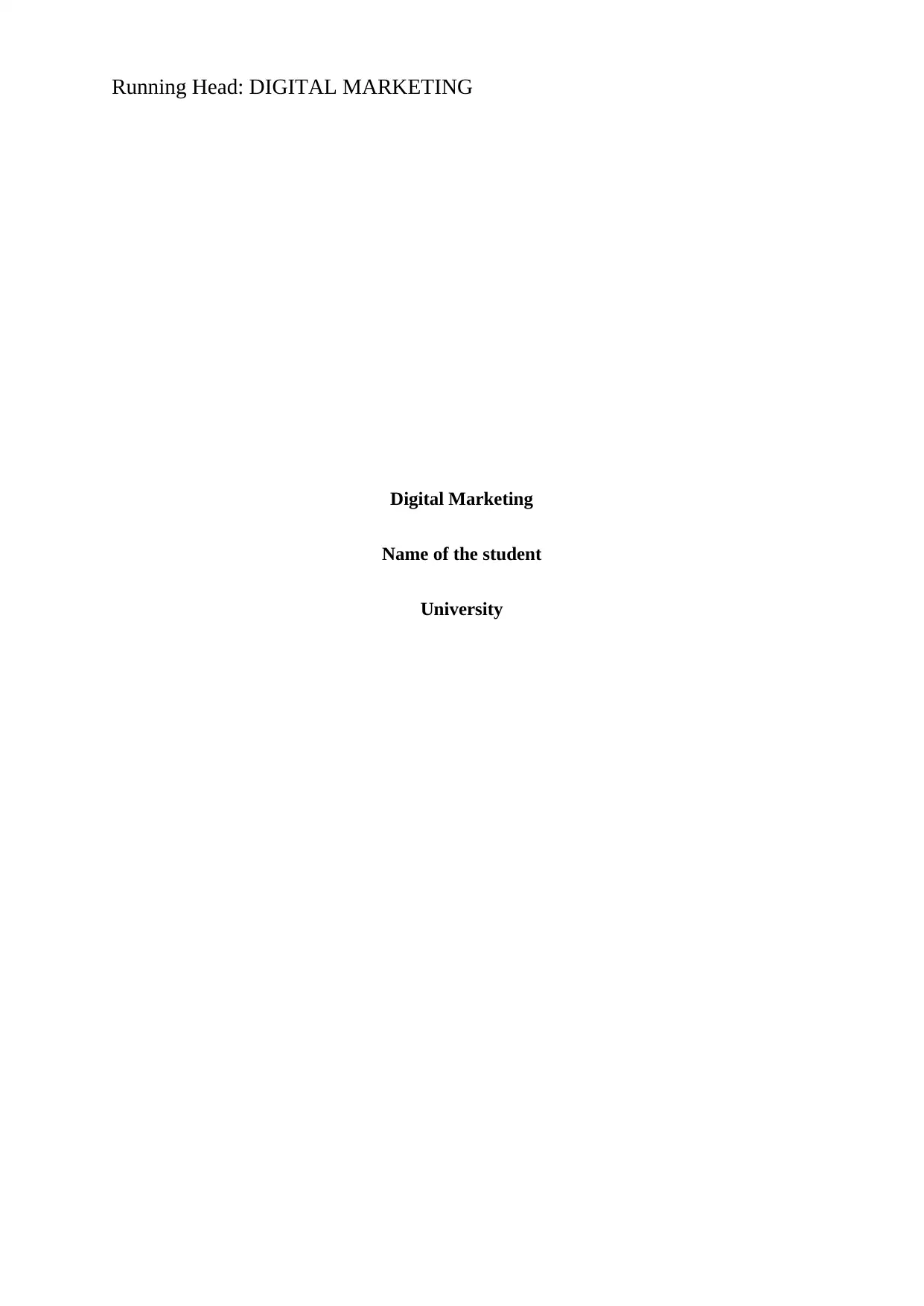
Running Head: DIGITAL MARKETING
Digital Marketing
Name of the student
University
Digital Marketing
Name of the student
University
Paraphrase This Document
Need a fresh take? Get an instant paraphrase of this document with our AI Paraphraser

1
DIGITAL MARKETING
Table of Contents
Introduction................................................................................................................................3
Customer Journey Mapping.......................................................................................................3
Customer Conversion and Retention Strategy...........................................................................6
Strategy for Conversion.........................................................................................................7
Customer Persona.......................................................................................................................7
Customer Conversion- Case Study............................................................................................7
Explanation........................................................................................................................9
Conversion strategy................................................................................................................9
1. Product...................................................................................................................10
2. Place.......................................................................................................................11
3. Price.......................................................................................................................11
4. Promotion...............................................................................................................12
5. People.....................................................................................................................12
6. Process...................................................................................................................12
7. Physical evidence...................................................................................................12
Customer Retention..................................................................................................................14
Consumer Persona (Retention)............................................................................................14
Explanation......................................................................................................................15
Difference between conversion persona and retention persona...........................................15
DIGITAL MARKETING
Table of Contents
Introduction................................................................................................................................3
Customer Journey Mapping.......................................................................................................3
Customer Conversion and Retention Strategy...........................................................................6
Strategy for Conversion.........................................................................................................7
Customer Persona.......................................................................................................................7
Customer Conversion- Case Study............................................................................................7
Explanation........................................................................................................................9
Conversion strategy................................................................................................................9
1. Product...................................................................................................................10
2. Place.......................................................................................................................11
3. Price.......................................................................................................................11
4. Promotion...............................................................................................................12
5. People.....................................................................................................................12
6. Process...................................................................................................................12
7. Physical evidence...................................................................................................12
Customer Retention..................................................................................................................14
Consumer Persona (Retention)............................................................................................14
Explanation......................................................................................................................15
Difference between conversion persona and retention persona...........................................15
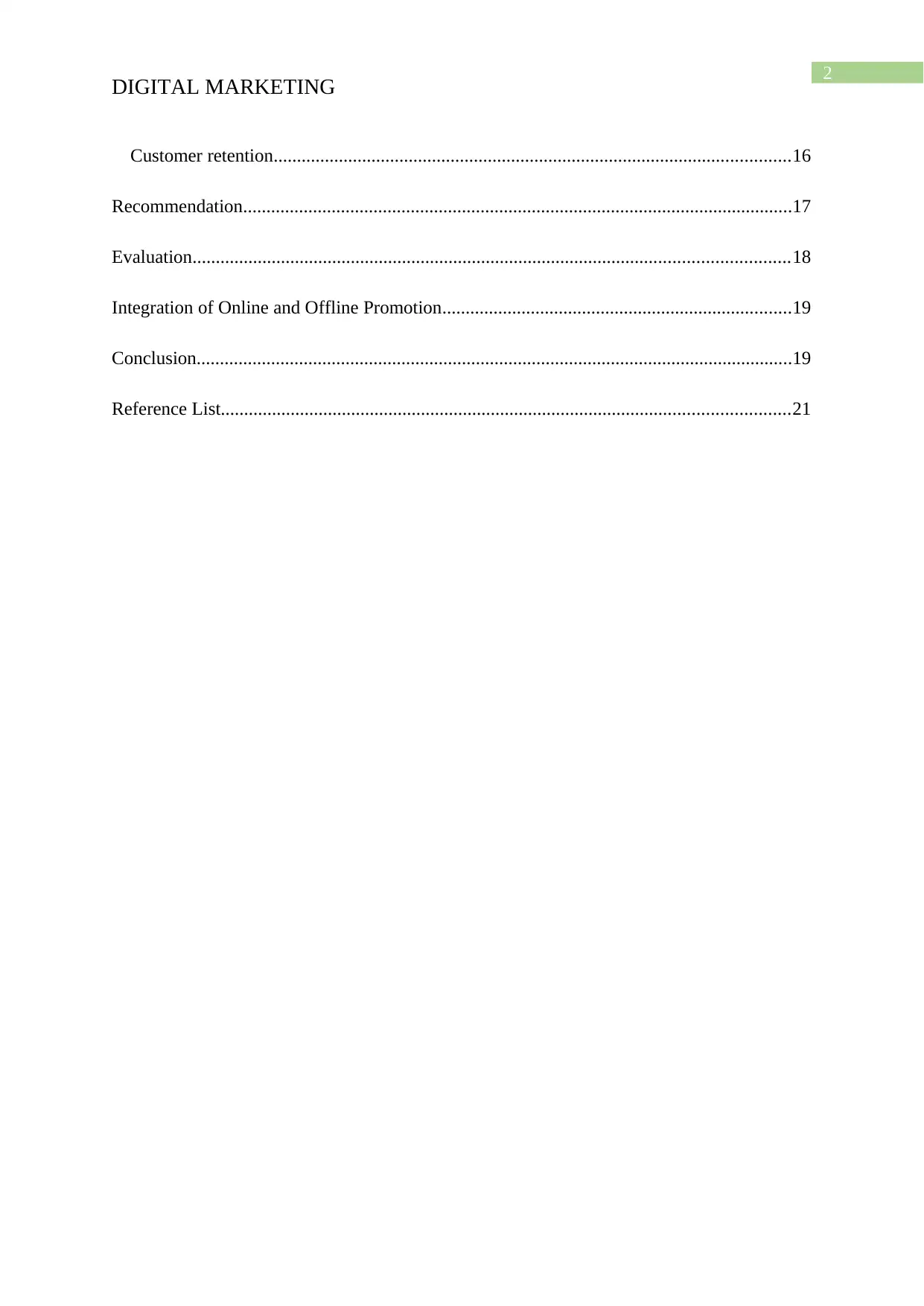
2
DIGITAL MARKETING
Customer retention...............................................................................................................16
Recommendation......................................................................................................................17
Evaluation................................................................................................................................18
Integration of Online and Offline Promotion...........................................................................19
Conclusion................................................................................................................................19
Reference List..........................................................................................................................21
DIGITAL MARKETING
Customer retention...............................................................................................................16
Recommendation......................................................................................................................17
Evaluation................................................................................................................................18
Integration of Online and Offline Promotion...........................................................................19
Conclusion................................................................................................................................19
Reference List..........................................................................................................................21
⊘ This is a preview!⊘
Do you want full access?
Subscribe today to unlock all pages.

Trusted by 1+ million students worldwide

3
DIGITAL MARKETING
Introduction
Marketing strategy is the most significant aspect of a growing organization. It can be
described as the action plan of an organization to promote and sell their services or products.
The major aim of marketing strategy is to acquire new customers, convert them to loyal
consumers and retain that clientele. Organizations have adopted various strategies to promote
their business over the time. Especially, in the age of globalization and online media
revolution, digital marketing has been identified as a potential instrument for the growth and
prosperity of an organization. It is the method of promoting and marketing of products or
services through digital media such as search engines, social network platforms, websites,
mobile applications, email etc. (Chaffey and Ellis-Chadwick 2019)
In the present paper, the concept of digital marketing strategy will be discussed using
the case study of the not-for-profit organization Life Trust. The paper will take note of the
background, customer journey mapping and customer persona of the organization. Further, it
will critically analyse their digital marketing strategy to acquire, convert and retain their
clientele and evaluate their digital marketing mix to examine their business strategies in order
to prosper and ensure their business growth in UK.
Customer Journey Mapping
Customer journey mapping helps an organisation to understand the performance and
growth of the business from the customer’s perspective. The insight enables the organisation
determine the strategies to improve the customer experience and forecast customer needs in
DIGITAL MARKETING
Introduction
Marketing strategy is the most significant aspect of a growing organization. It can be
described as the action plan of an organization to promote and sell their services or products.
The major aim of marketing strategy is to acquire new customers, convert them to loyal
consumers and retain that clientele. Organizations have adopted various strategies to promote
their business over the time. Especially, in the age of globalization and online media
revolution, digital marketing has been identified as a potential instrument for the growth and
prosperity of an organization. It is the method of promoting and marketing of products or
services through digital media such as search engines, social network platforms, websites,
mobile applications, email etc. (Chaffey and Ellis-Chadwick 2019)
In the present paper, the concept of digital marketing strategy will be discussed using
the case study of the not-for-profit organization Life Trust. The paper will take note of the
background, customer journey mapping and customer persona of the organization. Further, it
will critically analyse their digital marketing strategy to acquire, convert and retain their
clientele and evaluate their digital marketing mix to examine their business strategies in order
to prosper and ensure their business growth in UK.
Customer Journey Mapping
Customer journey mapping helps an organisation to understand the performance and
growth of the business from the customer’s perspective. The insight enables the organisation
determine the strategies to improve the customer experience and forecast customer needs in
Paraphrase This Document
Need a fresh take? Get an instant paraphrase of this document with our AI Paraphraser
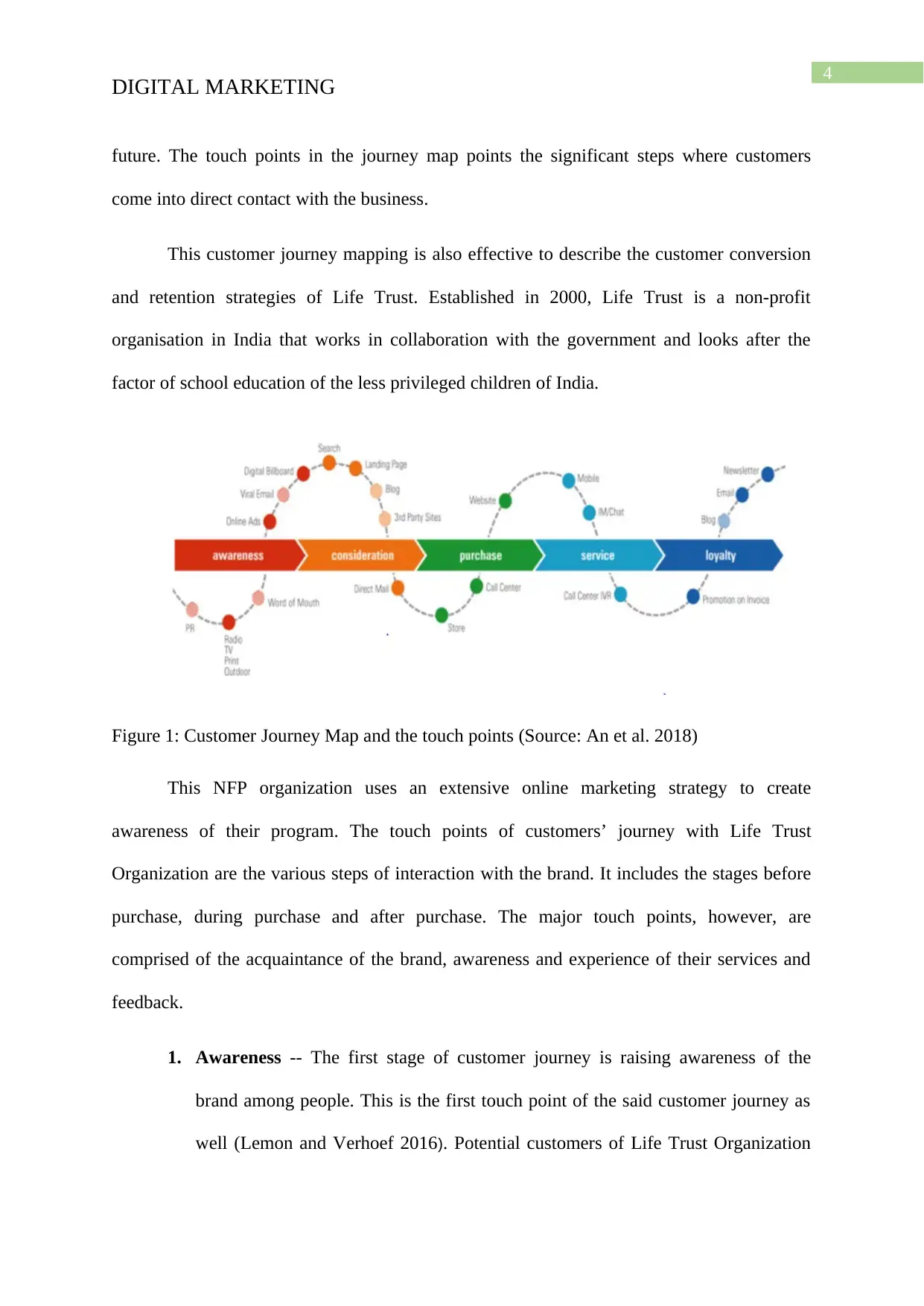
4
DIGITAL MARKETING
future. The touch points in the journey map points the significant steps where customers
come into direct contact with the business.
This customer journey mapping is also effective to describe the customer conversion
and retention strategies of Life Trust. Established in 2000, Life Trust is a non-profit
organisation in India that works in collaboration with the government and looks after the
factor of school education of the less privileged children of India.
Figure 1: Customer Journey Map and the touch points (Source: An et al. 2018)
This NFP organization uses an extensive online marketing strategy to create
awareness of their program. The touch points of customers’ journey with Life Trust
Organization are the various steps of interaction with the brand. It includes the stages before
purchase, during purchase and after purchase. The major touch points, however, are
comprised of the acquaintance of the brand, awareness and experience of their services and
feedback.
1. Awareness -- The first stage of customer journey is raising awareness of the
brand among people. This is the first touch point of the said customer journey as
well (Lemon and Verhoef 2016). Potential customers of Life Trust Organization
DIGITAL MARKETING
future. The touch points in the journey map points the significant steps where customers
come into direct contact with the business.
This customer journey mapping is also effective to describe the customer conversion
and retention strategies of Life Trust. Established in 2000, Life Trust is a non-profit
organisation in India that works in collaboration with the government and looks after the
factor of school education of the less privileged children of India.
Figure 1: Customer Journey Map and the touch points (Source: An et al. 2018)
This NFP organization uses an extensive online marketing strategy to create
awareness of their program. The touch points of customers’ journey with Life Trust
Organization are the various steps of interaction with the brand. It includes the stages before
purchase, during purchase and after purchase. The major touch points, however, are
comprised of the acquaintance of the brand, awareness and experience of their services and
feedback.
1. Awareness -- The first stage of customer journey is raising awareness of the
brand among people. This is the first touch point of the said customer journey as
well (Lemon and Verhoef 2016). Potential customers of Life Trust Organization
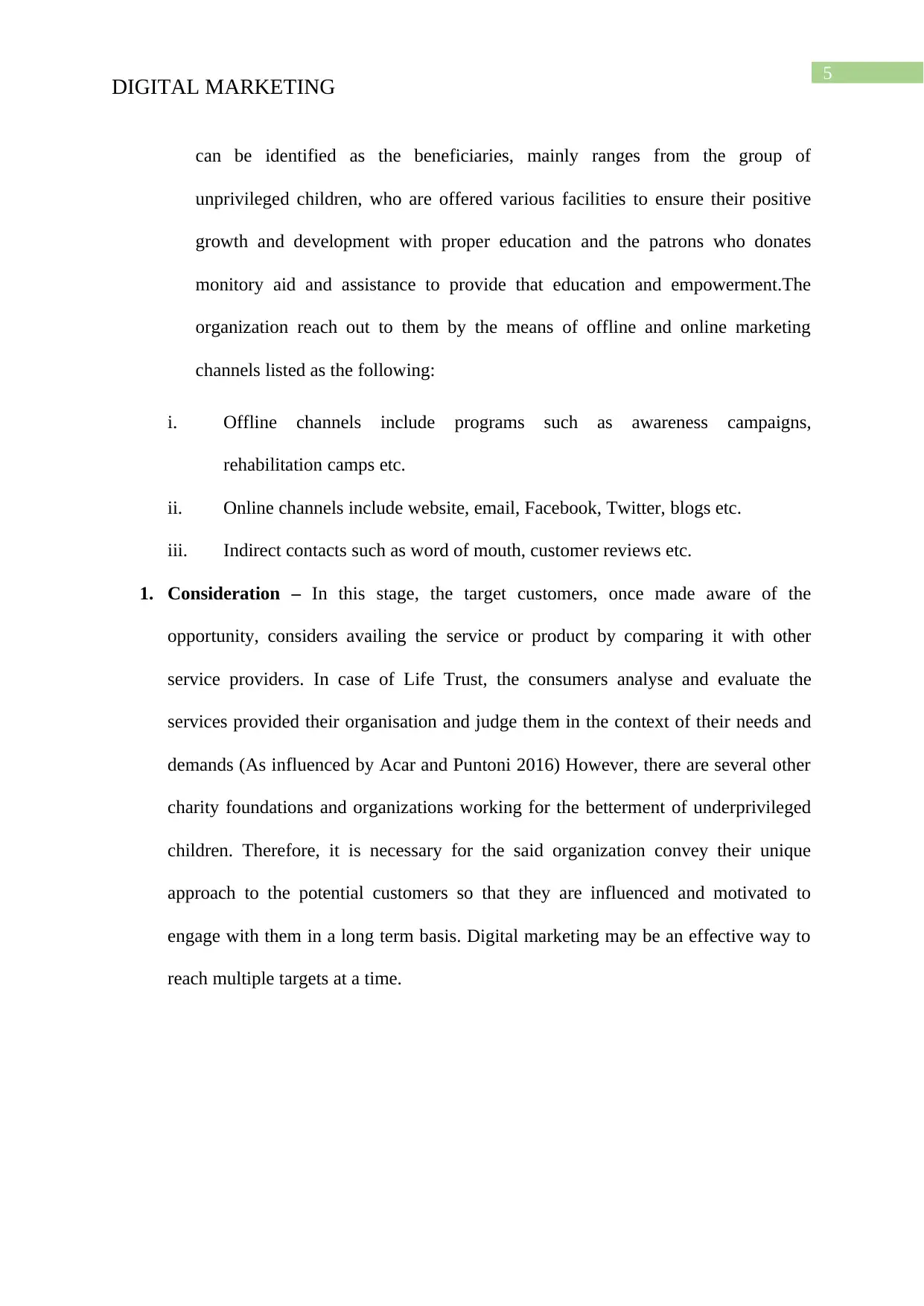
5
DIGITAL MARKETING
can be identified as the beneficiaries, mainly ranges from the group of
unprivileged children, who are offered various facilities to ensure their positive
growth and development with proper education and the patrons who donates
monitory aid and assistance to provide that education and empowerment.The
organization reach out to them by the means of offline and online marketing
channels listed as the following:
i. Offline channels include programs such as awareness campaigns,
rehabilitation camps etc.
ii. Online channels include website, email, Facebook, Twitter, blogs etc.
iii. Indirect contacts such as word of mouth, customer reviews etc.
1. Consideration – In this stage, the target customers, once made aware of the
opportunity, considers availing the service or product by comparing it with other
service providers. In case of Life Trust, the consumers analyse and evaluate the
services provided their organisation and judge them in the context of their needs and
demands (As influenced by Acar and Puntoni 2016) However, there are several other
charity foundations and organizations working for the betterment of underprivileged
children. Therefore, it is necessary for the said organization convey their unique
approach to the potential customers so that they are influenced and motivated to
engage with them in a long term basis. Digital marketing may be an effective way to
reach multiple targets at a time.
DIGITAL MARKETING
can be identified as the beneficiaries, mainly ranges from the group of
unprivileged children, who are offered various facilities to ensure their positive
growth and development with proper education and the patrons who donates
monitory aid and assistance to provide that education and empowerment.The
organization reach out to them by the means of offline and online marketing
channels listed as the following:
i. Offline channels include programs such as awareness campaigns,
rehabilitation camps etc.
ii. Online channels include website, email, Facebook, Twitter, blogs etc.
iii. Indirect contacts such as word of mouth, customer reviews etc.
1. Consideration – In this stage, the target customers, once made aware of the
opportunity, considers availing the service or product by comparing it with other
service providers. In case of Life Trust, the consumers analyse and evaluate the
services provided their organisation and judge them in the context of their needs and
demands (As influenced by Acar and Puntoni 2016) However, there are several other
charity foundations and organizations working for the betterment of underprivileged
children. Therefore, it is necessary for the said organization convey their unique
approach to the potential customers so that they are influenced and motivated to
engage with them in a long term basis. Digital marketing may be an effective way to
reach multiple targets at a time.
⊘ This is a preview!⊘
Do you want full access?
Subscribe today to unlock all pages.

Trusted by 1+ million students worldwide
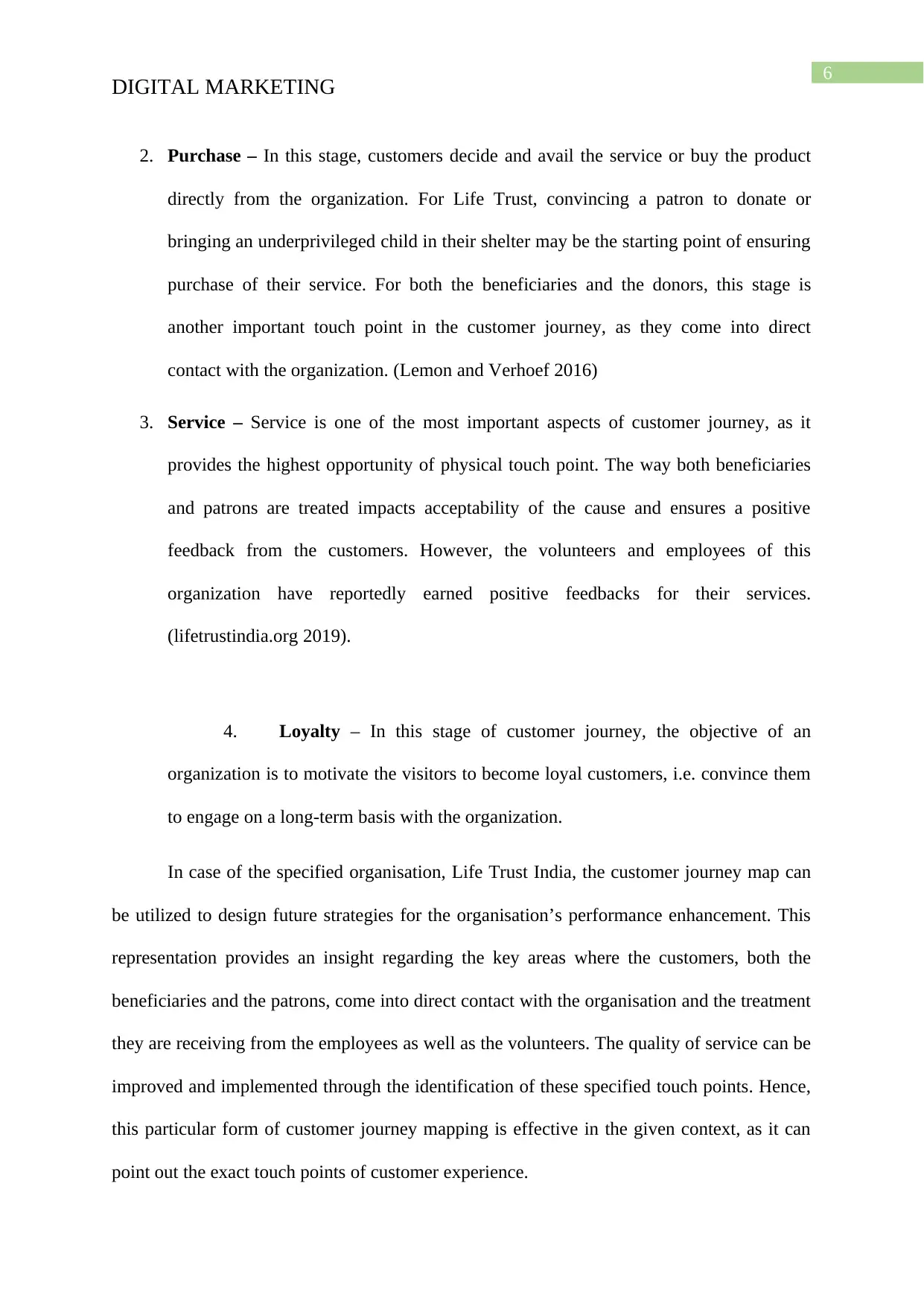
6
DIGITAL MARKETING
2. Purchase – In this stage, customers decide and avail the service or buy the product
directly from the organization. For Life Trust, convincing a patron to donate or
bringing an underprivileged child in their shelter may be the starting point of ensuring
purchase of their service. For both the beneficiaries and the donors, this stage is
another important touch point in the customer journey, as they come into direct
contact with the organization. (Lemon and Verhoef 2016)
3. Service – Service is one of the most important aspects of customer journey, as it
provides the highest opportunity of physical touch point. The way both beneficiaries
and patrons are treated impacts acceptability of the cause and ensures a positive
feedback from the customers. However, the volunteers and employees of this
organization have reportedly earned positive feedbacks for their services.
(lifetrustindia.org 2019).
4. Loyalty – In this stage of customer journey, the objective of an
organization is to motivate the visitors to become loyal customers, i.e. convince them
to engage on a long-term basis with the organization.
In case of the specified organisation, Life Trust India, the customer journey map can
be utilized to design future strategies for the organisation’s performance enhancement. This
representation provides an insight regarding the key areas where the customers, both the
beneficiaries and the patrons, come into direct contact with the organisation and the treatment
they are receiving from the employees as well as the volunteers. The quality of service can be
improved and implemented through the identification of these specified touch points. Hence,
this particular form of customer journey mapping is effective in the given context, as it can
point out the exact touch points of customer experience.
DIGITAL MARKETING
2. Purchase – In this stage, customers decide and avail the service or buy the product
directly from the organization. For Life Trust, convincing a patron to donate or
bringing an underprivileged child in their shelter may be the starting point of ensuring
purchase of their service. For both the beneficiaries and the donors, this stage is
another important touch point in the customer journey, as they come into direct
contact with the organization. (Lemon and Verhoef 2016)
3. Service – Service is one of the most important aspects of customer journey, as it
provides the highest opportunity of physical touch point. The way both beneficiaries
and patrons are treated impacts acceptability of the cause and ensures a positive
feedback from the customers. However, the volunteers and employees of this
organization have reportedly earned positive feedbacks for their services.
(lifetrustindia.org 2019).
4. Loyalty – In this stage of customer journey, the objective of an
organization is to motivate the visitors to become loyal customers, i.e. convince them
to engage on a long-term basis with the organization.
In case of the specified organisation, Life Trust India, the customer journey map can
be utilized to design future strategies for the organisation’s performance enhancement. This
representation provides an insight regarding the key areas where the customers, both the
beneficiaries and the patrons, come into direct contact with the organisation and the treatment
they are receiving from the employees as well as the volunteers. The quality of service can be
improved and implemented through the identification of these specified touch points. Hence,
this particular form of customer journey mapping is effective in the given context, as it can
point out the exact touch points of customer experience.
Paraphrase This Document
Need a fresh take? Get an instant paraphrase of this document with our AI Paraphraser
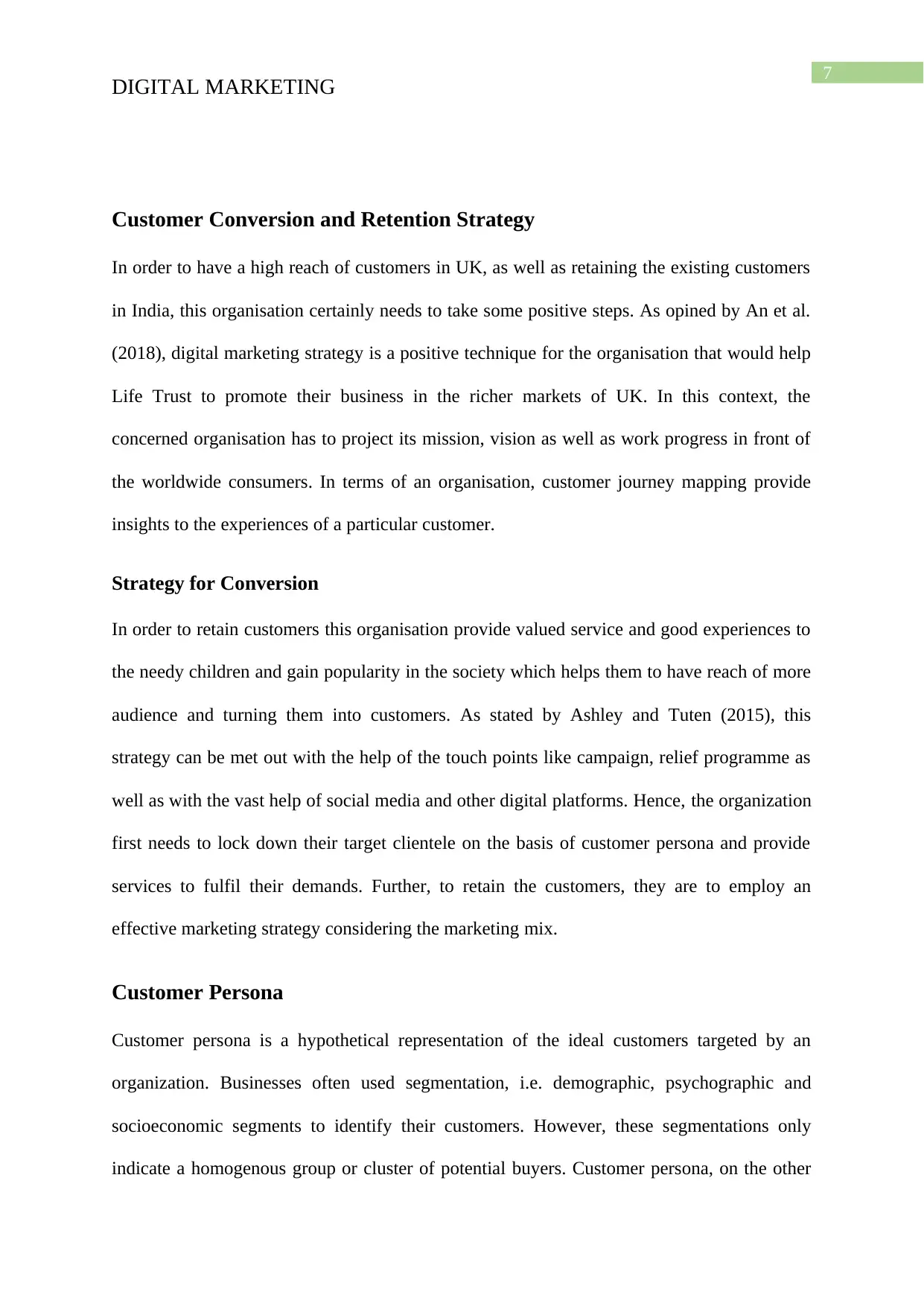
7
DIGITAL MARKETING
Customer Conversion and Retention Strategy
In order to have a high reach of customers in UK, as well as retaining the existing customers
in India, this organisation certainly needs to take some positive steps. As opined by An et al.
(2018), digital marketing strategy is a positive technique for the organisation that would help
Life Trust to promote their business in the richer markets of UK. In this context, the
concerned organisation has to project its mission, vision as well as work progress in front of
the worldwide consumers. In terms of an organisation, customer journey mapping provide
insights to the experiences of a particular customer.
Strategy for Conversion
In order to retain customers this organisation provide valued service and good experiences to
the needy children and gain popularity in the society which helps them to have reach of more
audience and turning them into customers. As stated by Ashley and Tuten (2015), this
strategy can be met out with the help of the touch points like campaign, relief programme as
well as with the vast help of social media and other digital platforms. Hence, the organization
first needs to lock down their target clientele on the basis of customer persona and provide
services to fulfil their demands. Further, to retain the customers, they are to employ an
effective marketing strategy considering the marketing mix.
Customer Persona
Customer persona is a hypothetical representation of the ideal customers targeted by an
organization. Businesses often used segmentation, i.e. demographic, psychographic and
socioeconomic segments to identify their customers. However, these segmentations only
indicate a homogenous group or cluster of potential buyers. Customer persona, on the other
DIGITAL MARKETING
Customer Conversion and Retention Strategy
In order to have a high reach of customers in UK, as well as retaining the existing customers
in India, this organisation certainly needs to take some positive steps. As opined by An et al.
(2018), digital marketing strategy is a positive technique for the organisation that would help
Life Trust to promote their business in the richer markets of UK. In this context, the
concerned organisation has to project its mission, vision as well as work progress in front of
the worldwide consumers. In terms of an organisation, customer journey mapping provide
insights to the experiences of a particular customer.
Strategy for Conversion
In order to retain customers this organisation provide valued service and good experiences to
the needy children and gain popularity in the society which helps them to have reach of more
audience and turning them into customers. As stated by Ashley and Tuten (2015), this
strategy can be met out with the help of the touch points like campaign, relief programme as
well as with the vast help of social media and other digital platforms. Hence, the organization
first needs to lock down their target clientele on the basis of customer persona and provide
services to fulfil their demands. Further, to retain the customers, they are to employ an
effective marketing strategy considering the marketing mix.
Customer Persona
Customer persona is a hypothetical representation of the ideal customers targeted by an
organization. Businesses often used segmentation, i.e. demographic, psychographic and
socioeconomic segments to identify their customers. However, these segmentations only
indicate a homogenous group or cluster of potential buyers. Customer persona, on the other
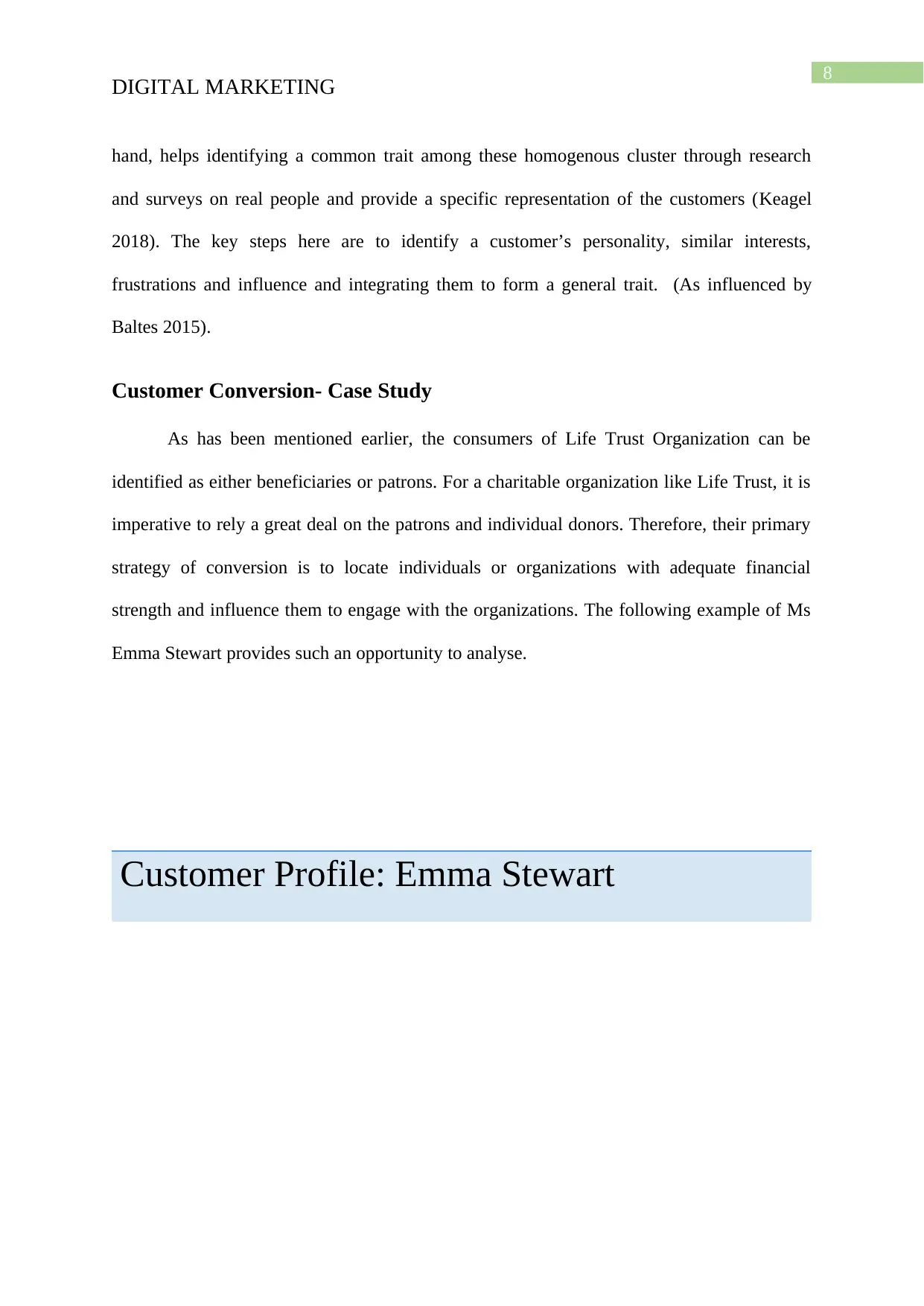
8
DIGITAL MARKETING
hand, helps identifying a common trait among these homogenous cluster through research
and surveys on real people and provide a specific representation of the customers (Keagel
2018). The key steps here are to identify a customer’s personality, similar interests,
frustrations and influence and integrating them to form a general trait. (As influenced by
Baltes 2015).
Customer Conversion- Case Study
As has been mentioned earlier, the consumers of Life Trust Organization can be
identified as either beneficiaries or patrons. For a charitable organization like Life Trust, it is
imperative to rely a great deal on the patrons and individual donors. Therefore, their primary
strategy of conversion is to locate individuals or organizations with adequate financial
strength and influence them to engage with the organizations. The following example of Ms
Emma Stewart provides such an opportunity to analyse.
Customer Profile: Emma Stewart
DIGITAL MARKETING
hand, helps identifying a common trait among these homogenous cluster through research
and surveys on real people and provide a specific representation of the customers (Keagel
2018). The key steps here are to identify a customer’s personality, similar interests,
frustrations and influence and integrating them to form a general trait. (As influenced by
Baltes 2015).
Customer Conversion- Case Study
As has been mentioned earlier, the consumers of Life Trust Organization can be
identified as either beneficiaries or patrons. For a charitable organization like Life Trust, it is
imperative to rely a great deal on the patrons and individual donors. Therefore, their primary
strategy of conversion is to locate individuals or organizations with adequate financial
strength and influence them to engage with the organizations. The following example of Ms
Emma Stewart provides such an opportunity to analyse.
Customer Profile: Emma Stewart
⊘ This is a preview!⊘
Do you want full access?
Subscribe today to unlock all pages.

Trusted by 1+ million students worldwide

9
DIGITAL MARKETING
(Source: www.Lifetrust@Facebook.com)
Explanation
Ms Stewart is a woman of late 40s working in the fashion industry. She belongs to an
upper-middle income group. Her spouse also works in a high-profile finance company.
Therefore, she is financially affluent as well as interested in human rights. Besides, she is
very much invested in charitable causes and volunteers in various initiatives for
underprivileged children and women. She is a prime example of Life Trust’s desired
customer persona as a patron. Therefore, through her subscriptions to websites, newsletters
and social media the organization can promote the initiative to her.
Conversion strategy
In order to convert visitors into customers, the organization needs to promote their
mission and vision in a strong way. Digital platforms can be an ideal medium for this drive.
Belongs to upper-middle income group
Works in fashion industry
Spouse also works in high-paying finance job
Customer
Personality
Has volunteered in organizations like Amnesty
International and Red Cross
Donates to local charities
Subscriber of newsletters and channels of
various human rights organization
Similar Interests
Works for underpriviledged children in her
locality
Interested in human rights
Follows Life Trust's Facebook page
Motivation and
Influence
DIGITAL MARKETING
(Source: www.Lifetrust@Facebook.com)
Explanation
Ms Stewart is a woman of late 40s working in the fashion industry. She belongs to an
upper-middle income group. Her spouse also works in a high-profile finance company.
Therefore, she is financially affluent as well as interested in human rights. Besides, she is
very much invested in charitable causes and volunteers in various initiatives for
underprivileged children and women. She is a prime example of Life Trust’s desired
customer persona as a patron. Therefore, through her subscriptions to websites, newsletters
and social media the organization can promote the initiative to her.
Conversion strategy
In order to convert visitors into customers, the organization needs to promote their
mission and vision in a strong way. Digital platforms can be an ideal medium for this drive.
Belongs to upper-middle income group
Works in fashion industry
Spouse also works in high-paying finance job
Customer
Personality
Has volunteered in organizations like Amnesty
International and Red Cross
Donates to local charities
Subscriber of newsletters and channels of
various human rights organization
Similar Interests
Works for underpriviledged children in her
locality
Interested in human rights
Follows Life Trust's Facebook page
Motivation and
Influence
Paraphrase This Document
Need a fresh take? Get an instant paraphrase of this document with our AI Paraphraser
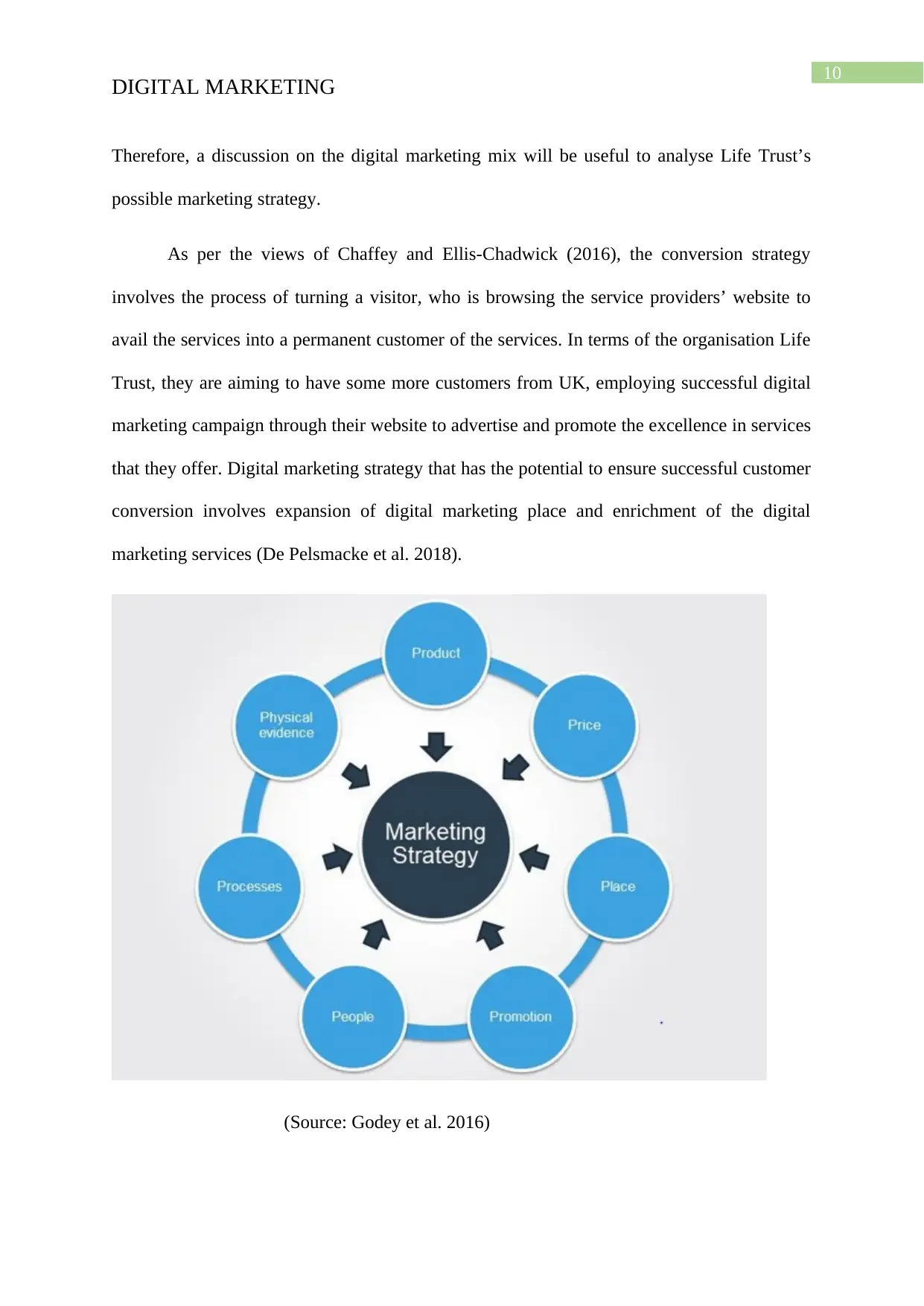
10
DIGITAL MARKETING
Therefore, a discussion on the digital marketing mix will be useful to analyse Life Trust’s
possible marketing strategy.
As per the views of Chaffey and Ellis-Chadwick (2016), the conversion strategy
involves the process of turning a visitor, who is browsing the service providers’ website to
avail the services into a permanent customer of the services. In terms of the organisation Life
Trust, they are aiming to have some more customers from UK, employing successful digital
marketing campaign through their website to advertise and promote the excellence in services
that they offer. Digital marketing strategy that has the potential to ensure successful customer
conversion involves expansion of digital marketing place and enrichment of the digital
marketing services (De Pelsmacke et al. 2018).
(Source: Godey et al. 2016)
DIGITAL MARKETING
Therefore, a discussion on the digital marketing mix will be useful to analyse Life Trust’s
possible marketing strategy.
As per the views of Chaffey and Ellis-Chadwick (2016), the conversion strategy
involves the process of turning a visitor, who is browsing the service providers’ website to
avail the services into a permanent customer of the services. In terms of the organisation Life
Trust, they are aiming to have some more customers from UK, employing successful digital
marketing campaign through their website to advertise and promote the excellence in services
that they offer. Digital marketing strategy that has the potential to ensure successful customer
conversion involves expansion of digital marketing place and enrichment of the digital
marketing services (De Pelsmacke et al. 2018).
(Source: Godey et al. 2016)
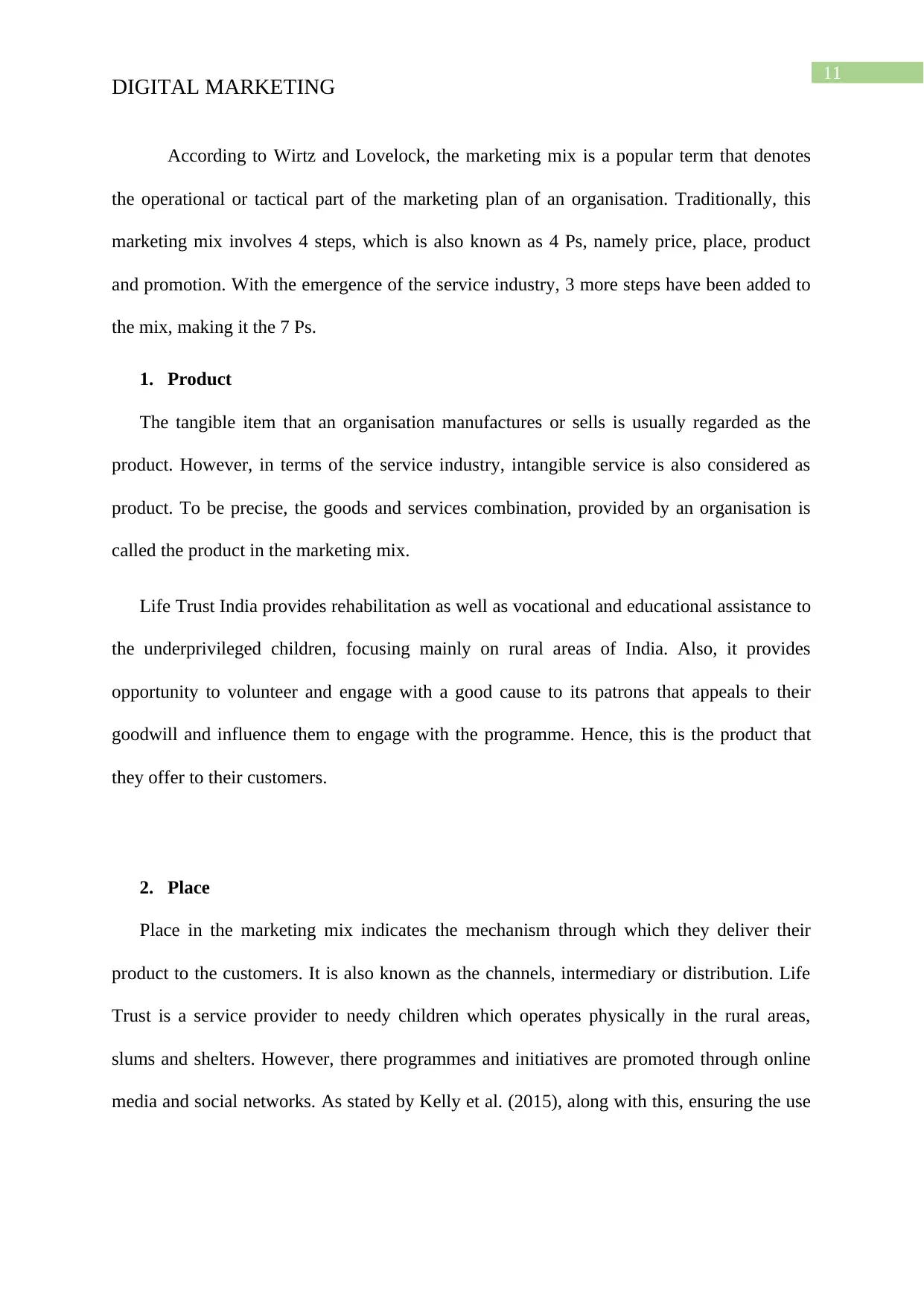
11
DIGITAL MARKETING
According to Wirtz and Lovelock, the marketing mix is a popular term that denotes
the operational or tactical part of the marketing plan of an organisation. Traditionally, this
marketing mix involves 4 steps, which is also known as 4 Ps, namely price, place, product
and promotion. With the emergence of the service industry, 3 more steps have been added to
the mix, making it the 7 Ps.
1. Product
The tangible item that an organisation manufactures or sells is usually regarded as the
product. However, in terms of the service industry, intangible service is also considered as
product. To be precise, the goods and services combination, provided by an organisation is
called the product in the marketing mix.
Life Trust India provides rehabilitation as well as vocational and educational assistance to
the underprivileged children, focusing mainly on rural areas of India. Also, it provides
opportunity to volunteer and engage with a good cause to its patrons that appeals to their
goodwill and influence them to engage with the programme. Hence, this is the product that
they offer to their customers.
2. Place
Place in the marketing mix indicates the mechanism through which they deliver their
product to the customers. It is also known as the channels, intermediary or distribution. Life
Trust is a service provider to needy children which operates physically in the rural areas,
slums and shelters. However, there programmes and initiatives are promoted through online
media and social networks. As stated by Kelly et al. (2015), along with this, ensuring the use
DIGITAL MARKETING
According to Wirtz and Lovelock, the marketing mix is a popular term that denotes
the operational or tactical part of the marketing plan of an organisation. Traditionally, this
marketing mix involves 4 steps, which is also known as 4 Ps, namely price, place, product
and promotion. With the emergence of the service industry, 3 more steps have been added to
the mix, making it the 7 Ps.
1. Product
The tangible item that an organisation manufactures or sells is usually regarded as the
product. However, in terms of the service industry, intangible service is also considered as
product. To be precise, the goods and services combination, provided by an organisation is
called the product in the marketing mix.
Life Trust India provides rehabilitation as well as vocational and educational assistance to
the underprivileged children, focusing mainly on rural areas of India. Also, it provides
opportunity to volunteer and engage with a good cause to its patrons that appeals to their
goodwill and influence them to engage with the programme. Hence, this is the product that
they offer to their customers.
2. Place
Place in the marketing mix indicates the mechanism through which they deliver their
product to the customers. It is also known as the channels, intermediary or distribution. Life
Trust is a service provider to needy children which operates physically in the rural areas,
slums and shelters. However, there programmes and initiatives are promoted through online
media and social networks. As stated by Kelly et al. (2015), along with this, ensuring the use
⊘ This is a preview!⊘
Do you want full access?
Subscribe today to unlock all pages.

Trusted by 1+ million students worldwide
1 out of 25
Related Documents
Your All-in-One AI-Powered Toolkit for Academic Success.
+13062052269
info@desklib.com
Available 24*7 on WhatsApp / Email
![[object Object]](/_next/static/media/star-bottom.7253800d.svg)
Unlock your academic potential
Copyright © 2020–2025 A2Z Services. All Rights Reserved. Developed and managed by ZUCOL.



